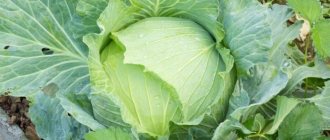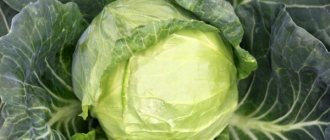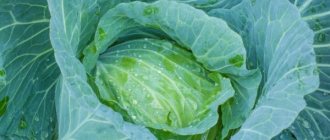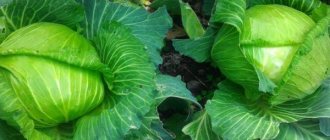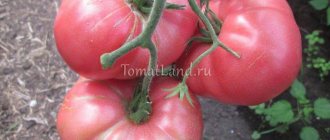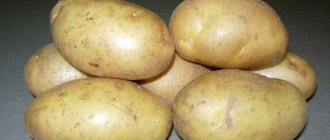Among the various types of cabbage, more and more often people involved in agriculture decide to grow one specific one. When choosing varieties of vegetables to plant on their plots, experienced farms and beginning gardeners try to give preference to an unpretentious variety that has good taste and resistance to pests and diseases. Kazachok cabbage does not depend on climatic conditions, is resistant to many diseases and pests, and also has an excellent taste, which allows you to make a wide variety of dishes from it.
Description of early cabbage Kazachok
Cabbage Cossack F1 is an early ripening hybrid. The period from transplanting to harvesting is about 45-55 days. Light green, round heads with a yellow-cream tint in cross section can weigh from 1.2 to 1.7 kg. Cossack is a medium-hard variety. The core and leaves of cabbage are small in size. This variety has excellent taste.
The Cossack has a good presentation
Landing
The hybrid seeds are ready for planting; just a short soaking is enough. The beds are prepared in the autumn season. When digging into the soil add:
- manure;
- compost;
- urea;
- potassium chloride.
When the soil is acidified (pH less than 5.6), dolomite or lime is used.
The ripening period begins in August and lasts until mid-autumn. Like all late-ripening varieties, cabbage stores well.
When to plant to get the harvest on time:
- Seeds for seedlings are sown from mid-April;
- in row method from the 2nd ten days of May;
- Bushes are transplanted into beds from mid-May.
Planting and caring for Kazachok cabbage
The planting system mainly depends on agricultural technology. To obtain quality products, it is important to regularly water and nourish the plants.
Although this variety can be grown by direct sowing of seeds in open soil, it is best to give preference to the seedling method if unfavorable climatic conditions require it.
To obtain an ultra-early ripening harvest, it is recommended to grow seedlings in a plastic container. Next, it must be moved to open ground at the age of 30-35 days. It is easier for plants to go through transplantation and take root at this particular age.
To plant seeds for seedlings, it is best to prepare a soil mixture. It should contain ingredients such as calcined turf soil, soil baking powder and Fitosporin.
During the first 7 days, the soil with the planted seeds should be kept in a cool room, the temperature of which does not exceed 8 ℃. In the next 7 days it is doubled. Watering the sprouts should be done when the soil dries out from previous soil moisture.
The Cossack needs proper care, which will be the key to a good harvest.
Attention! The water used to water the seedlings should be cool.
The sprouts will be ready for planting in open ground after 45-50 days. This procedure is best performed in cool and damp weather conditions. This will help young plants not to dry out in open sunlight.
If the time for transplanting seedlings has already come, and it is hot and dry outside, you must proceed as follows:
- Moisten the planting soil as much as possible.
- Plant the seedlings in the evening.
If hot weather conditions persist for 10-14 days after planting, the seedlings should be protected from the sun. To do this, you can resort to old methods, for example, burdock leaves. An important condition is to clean the protection in the evening. If this is not done, the seedlings may rot.
The trunks of seedlings transferred to open soil should not be exposed. Plants should be planted firmly and securely in the ground. To do this, you need to loosen the soil and sprinkle it near the cabbage trunks.
After transplanting the Cossack into open soil, the plants should be watered once every two days. The ideal option for watering this variety of cabbage is warm water, but cool water is also suitable.
The development of all varieties of cabbage, including Cossack F1, is better if the required level of nitrogen is maintained in non-acidic soil. To reduce the acidity level, ash is added to the soil, and to increase it, the plants should be fed with urea a month after the first shoots.
Throughout the entire period of growth and development, cabbage of this variety should be fed twice more. For this procedure, you can use a mixture of part mullein infusion to 3 parts water.
Advice! The first feeding consists of a urea mixture (1 g of urea per 1 liter of infusion). The latter should be supplemented with complex fertilizers containing superphosphate and potassium.
How and when to plant
It is necessary to start preparing the beds in the fall. For this purpose, carefully dig up the soil onto the bayonet of a shovel. During digging, it is necessary to add organic matter - manure or humus. Mineral compounds - urea, superphosphate, potassium chloride - will not interfere.
With the onset of spring, dig up the soil again, only at the same time try to develop earthen comas as thoroughly as possible. If the soil is acidic, then it is necessary to add lime or dolomite flour to it. It is worth planting seedlings in mid-May. In this case, a distance of 30-40 cm must be maintained between the rows.
Video shows how to plant cabbage:
Planting of seedlings occurs in already prepared holes. They should be watered and then sent one root at a time. Deepen the seedling to the first leaf, then lightly compact the layer of soil and water again.
The video from the article will help you understand how cabbage is sprayed with boric acid for ovaries, and how effective this product is.
It will also be useful and interesting to learn about how to sprinkle cabbage with folk remedies against pests.
But what to do to get cabbage heads to set, and what means should be used, is indicated here: //gidfermer.com/sadovodstvo/ovoshhevodstvo/chem-polit-kapustu-chtoby-zavyazalis-kochany.html
It may also be useful for you to learn about how to water cabbage in open ground.
Diseases and pests
This variety is resistant to diseases that cause mucous bacteriosis. Cossack is also resistant to blackleg disease when growing seedlings.
Maintaining the right conditions for the Cossack plant will protect the crop from cabbage whites, slugs and cruciferous flea beetles.
The main way to protect cabbage from parasites is to plant plants such as mint, calendula and marigolds near the bushes. The essential oils they contain will repel harmful insects.
To process Cossack, it is recommended to use Fitoverm. It is this drug that has a positive effect on early varieties of cabbage.
Advantages and disadvantages inherent in vegetables
The strengths of cabbage include the following:
- earlier fruit ripening;
- resistance to sudden temperature changes;
- the plant is rarely affected by diseases, including bacteriosis - vascular and mucous, as well as blackleg;
- high taste qualities;
- excellent presentation.
Ultra-early crops also have several negative characteristics:
- The crop does not tolerate extreme heat, so experts do not recommend growing it in the southern regions.
- Cabbage does not tolerate shaded areas.
- Not used, like other early varieties, for pickling and salting.
Application
Kazachok cabbage is suitable for eating raw, adding to salads, soups, and stews. Vegetables of this variety can be boiled, stewed, baked and steamed. Cabbage can be served as an independent dish or a side dish with meat products. It can also be used to stuff pies and pies. Cossack is well suited for making sauerkraut, borscht and cabbage rolls.
The Kazachok variety makes good sauerkraut
Features of cultivation
Preparing seedlings
Preparing seedlings is one of the most important tasks for gardeners. Before sowing, the seeds are placed in hot water for about 20 - 30 minutes, and then in cold water for a minute. After this, the seeds are kept in a special solution for 12 hours, washed and left in the refrigerator. To increase the efficiency of temperature treatment, it is advisable to use a solution of potassium permanganate, as it prepares the seeds for further development.
Cabbage seedlings should be grown in nutritious soil, which consists of peat, sand and turf soil. All components are mixed in equal proportions. You can prepare the soil yourself or buy it at a specialty store.
Sowing
Sowing late cabbage is always carried out according to a certain pattern, which corresponds to any other vegetable varieties.
Seeds are always placed in the soil to a depth of one and a half centimeters, after which the seedlings are provided with the necessary conditions for their successful development.
Cabbage seedlings are grown using one of two suitable methods.
- Picking. In this case, small and low boxes are filled with a substrate in which recesses are made for the seeds. Then the seeds are placed at a distance of about a couple of centimeters from each other, the soil is compacted and watered. After the first leaf appears, the seedlings can be transplanted into an individual cup with fresh soil, which will involve picking.
- No picking. It is assumed that it is possible to sow 2 – 3 seeds in separate containers. After the seedlings grow a little, they are thinned out. It is recommended to leave only a strong sprout, which will be grown in the future.
Both options are suitable as they can guarantee the growth of late cabbage.
Main features of growing cabbage:
- It is recommended to sow seeds at a temperature of +18 – 20 degrees;
- after the sprouts sprout, the air is cooled to about +10 degrees;
- intense and long-term lighting is mandatory, since the duration of daylight hours should be at least 12 hours;
- watering the sprouts should not be too frequent, but it is advisable to focus on the condition of the soil;
- Fertilizing seedlings is mandatory, and it is carried out twice or three times with the obligatory use of microelements, potassium sulfate and urea.
Subsequently, it becomes possible to plant late cabbage in open ground as seedlings, but it is advisable to focus on the timing of growing vegetables and the condition of the cabbage.
Soil preparation
Cabbage seedlings can be planted in the soil only after 5–6 leaves appear. A couple of weeks before this event, it is advisable to harden the cabbage seedlings, and for this it is enough to take them outside every day.
For further planting, it is advisable to choose only those areas that are illuminated by the sun and where grains and legumes, potatoes and cucumbers previously grew. If other cruciferous vegetables grew on the ground, cabbage can be planted after a few years.
Transfer
To plant late cabbage, it is recommended to loosen and level the soil. Then small holes are made at a distance of 70 cm from each other, and the beds should be at a distance of 60 cm. It is advisable to place the plants in the created depressions along with a lump of earth to preserve the root system. Transplantation also involves compacting the soil and watering the seedlings, and this largely determines how successfully the vegetable crops will grow.
The best late ripening cabbage
Late-ripening crops are considered the most productive. This type of cabbage is safer for health; vegetables accumulate nitrates in their leaves to a lesser extent. Late varieties are used for pickling, cabbage rolls and vegetable stews are prepared from them. Cabbage takes a very long time to ripen - almost 130-160 days. If stored properly, fresh heads of cabbage can last until the spring of next year.
Late varieties are characterized by excellent resistance to diseases and rot. The heads of cabbage are plump, not too sweet, but over time the taste becomes more pleasant. The late one can stand in the garden until frost.
Aggressor F1
Late Dutch hybrid. The plant is viable and can withstand any weather conditions. Cabbage can grow in nutrient-poor soil. Vegetables are grown in all regions of Russia, even in the driest ones. The weight of a mature head is 3.5-5 kilograms. The heads are round and plump. The upper leaves are dark green and wavy. When cut, the head of cabbage is white, with a slight yellowish tint. Mature heads do not crack. The crop rarely gets sick; the real threat is whitefly and aphids.
Moscow late
Popular culture, developed back in 1937. The leaf rosette is spreading, almost 1 meter in diameter. The outer leaves are gray-green, with a waxy coating. Ripe heads of cabbage are huge and dense. The weight of one is 4-6 kilograms. The inside of the cabbage is white. An ideal variety for pickling. Fresh heads are stored until February.
Mara
Culture developed in Belarus. Cabbage rarely gets sick and almost never rots. Can be stored until spring. The weight of the head of cabbage is about 4 kilograms. Excellent for pickling.
Amager 611
Can be grown in any region. Not afraid of frost. The cabbage rosette is slightly raised, its diameter is up to 80 centimeters. The leaves are smooth, the upper ones are slightly wrinkled. Ripe cabbage has a dense, round head. The mass of one is about 4 kilograms. The crop is specially grown for long-term winter storage. The longer cabbage is stored, the tastier it becomes. Over time, the bitterness disappears, the leaves become soft and juicy.
Langedijker
Vegetable crop developed in Germany. The cabbage head is gray-green on top and white on the inside. The average weight of one specimen is 3-5 kilograms. Ripe vegetables have a sweetish taste. The crop can become infected with clubroot and tobacco mosaic. Picked vegetables are stored for a long time and are used for pickling.
Sugarloaf
A late winter-hardy crop developed in Russia. The rosette is raised, huge, spreading, up to 0.8 meters in diameter. The upper leaves are large, gray-green, with a waxy coating. Ripe heads of cabbage are plump, crispy, juicy, and white in cross-section. The mass of one is 3.5 kilograms.
It is better to pick vegetables after frost. They become sweeter and tastier. Cabbage is used for pickling and can be stored until spring. Vegetables taste a little bitter immediately after harvesting from the garden. After a month, the bitterness disappears. Vegetables can be eaten fresh or processed.
Kolobok
Hybrid bred in Russia. The culture is demanding on the soil. Does not tolerate lack of moisture well. The outer leaves are slightly raised. Cabbage has a compact appearance, the diameter of the rosette is about 0.5 meters. The culture is perfectly stored (up to 7 months), has a dense head of delicate yellowish-white color. The weight of one vegetable is up to 4.5 kilograms.
We create good conditions for growth
It all starts with a properly prepared bed. The plant needs a lot of light, it does not tolerate cold winds well, plantings are shaded from northern currents. It will receive good lighting all day if the ridges are positioned from north to south.
We should also remember our predecessors. Plants of the cruciferous family are not allowed. Cucumbers, potatoes or onions would be good for this.
The soil should be fertile, enriched with peat and humus, not acidic. To do this, we add dolomite flour, which also increases the magnesium content, which improves the taste of the fruit.
Soil with dolomite flour
It is better to prepare the beds in the fall. Remove plant debris and loosen the soil. We apply organic and mineral fertilizers. In the fall you can apply fresh manure; by spring it will burn out and be useful. Add potassium and superphosphate. Sand or peat is mixed into heavy soils. High ridges are made in low places so that the plants do not get wet.
A good way to increase fertility and cleanse the soil is to sow green manure. For this crop it is good to use grains and legumes, mustard.
How to care for a plant in open ground
Cabbage loves warmth and humidity. In hot weather, watering is needed at least three times a week; do not let the soil dry out. Watering should be done in the evening when there is less evaporation. The water should be warm. Abundant watering for early cabbage is important in July - during the formation of heads of cabbage.
Mulch with peat, humus or just soil. Together with hilling, this helps retain moisture and nourishes the roots. Cabbage is fed with complete mineral fertilizer (consisting of phosphorus, nitrogen, potassium), with the addition of microelements. We apply the first doses of fertilizer three weeks after planting in the ground.
Do not forget to remove weeds from cabbage beds in a timely manner. They shade plantings, take away food, and serve as a breeding ground for pests and diseases.
Transplanting seedlings into open ground
If you have been preparing the beds since the fall, there will be much less work. We loosen the soil, remove weeds, and add nitrogen fertilizers. Starting from May 5th, we transplant the seedlings into the garden bed. We use a planting scheme of 45 cm by 45 cm. We plant only healthy, strong plants. We fill the holes with water and deepen the plants to the cotyledon leaves. We choose cloudy days when planting plants; on sunny days, seedlings need to be shaded throughout the first week.
Next we water, loosen, feed. The Cossack hybrid is resistant to various pests and rots and does not suffer from blackleg. This makes it easier to care for.
Cabbage seedlings ready for transplanting into the ground
